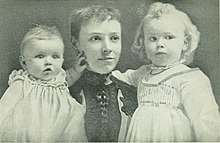Helen Herron Taft
Herron married Taft in 1886, and she guided him throughout his political career, encouraging him to take actions that would bring him closer to the presidency.
After her husband was appointed Secretary of War, she played a significant role in convincing him to run for president in the 1908 presidential election and making the necessary connections to ensure his success.
As first lady, Taft was closely involved in the political aspects of the presidency, regularly sitting in on meetings and serving as her husband's closest advisor.
She held a strong influence over the president's decisions, expressing her concerns when she disagreed with him and providing her input on presidential appointments.
Inspired by her experience in the Philippines, she converted the White House lawn and the West Potomac Park into social hubs with regular live shows and events.
Taft's influence as first lady was cut short by a stroke two months into her tenure, permanently limiting her mobility and leaving her absent for a year while she partially recovered.
[2]: 126 Her father was an associate of two future presidents: he was a college classmate of Benjamin Harrison and a law partner of Rutherford B. Hayes,[1]: 173 while her mother was the daughter and the sister of U.S.
[6]: 321 As a teenager, Herron would rebel against the societal expectations for upper class women; by the age of 15 she had secretly begun smoking cigarettes, drinking whiskey, and gambling.
[7]: 95 Seeking a channel for her ambition and independence, she enrolled in Cincinnati's prestigious Miss Nourse School for Girls where she was educated in many subjects, including several languages.
[9][10] This visit instilled in Herron a strong desire to return to the White House as first lady, one that she would often present to her eventual husband.
[7]: 96 Taft worried about their political future when her husband accepted a five-year term on the Cincinnati Superior Court in 1888, but she was optimistic after he was appointed Solicitor General of the United States in 1890,[6]: 324 a position which she had helped him in obtaining through her acquaintance with President Harrison.
[8]: 175 Among her closest friends in Washington were the family of Attorney General William H. H. Miller and the wives of the Supreme Court justices.
[11] Taft's treatment of the Filipino people contributed to improved relations with the country, including her work to end the system of racial segregation that had previously been in place.
[1]: 176 The winter was difficult for Taft, as she was exhausted from the constant stress of her role in the Philippines, compounded by her husband needing two surgeries, and both of her parents suffering from strokes, her mother's proving fatal.
[4]: 328 Taft accompanied her husband on a trip to Italy in 1902, where she was treated as a guest of honor and was personally received by Pope Leo XIII.
[6]: 326 His work in the Department of War did allow for more travel, providing Taft with a chance to learn more of international politics and make connections abroad.
Taft found the experience more intensive than she had expected, and she was deeply embarrassed by one incident in which she lost track of the week and she was seen playing cards with her husband on the Lord's Day.
[6]: 328 In May 1909, shortly after her husband's term began, Taft suffered a stroke, impairing her speech and limiting movement in right arm and leg.
[14] Taft had grown accustomed to the royal style of treatment that she had experienced in the Philippines, and she wished to establish a similar regal environment as White House hostess.
[15]: 24 She sought to improve the social traditions associated with the White House while she was first lady; she changed the locations of events to make them more efficient, and she introduced dancing at formal receptions.
[1]: 178 She made extensive use of the White House lawn, hosting garden parties, theatrical shows, and music performances.
[6]: 328 In the time that she was recovering from her stroke in 1909, Taft took a less active role in organizing events, having her sisters and her daughter supporting her in the duties of White House hostess.
She declined to participate in luncheons with the wives of cabinet members, feeling that they were of little consequence and simply a means of putting her aside as a woman.
She felt that the presidential salary of $75,000 was well above what they needed, she reduced their spending to $50,000 per year, accumulating a savings of $100,000 by the end of her husband's term.
[2]: 133 Among her cost-saving practices were the purchase of foods wholesale and the care of a cow on White House grounds to provide milk and butter.
The Tafts attended symphony, opera, and theater performances in Washington, D.C.; she started another summer tradition at West Potomac Park with the United States Marine Band playing for the public.
She managed his appearance and scheduling to ensure he maintained proper presentation, and she would provide him with political information such as names and statistics as he needed them.
[6]: 330 In 1912, she attended a House Rules committee inquiry to hear testimonies of police brutality against women, bringing awareness to the issue.
[5]: 214 In 1914, Taft became the first first lady to publish a memoir with the publication of Recollections of Full Years, which had been written with her daughter Helen and journalist Eleanor Egan.
[8]: 180 The Tafts continued to travel after retiring from the White House, visiting Bermuda, Panama, England, and Italy, being greeted in the latter two countries by King George V and the Pope, respectively.





